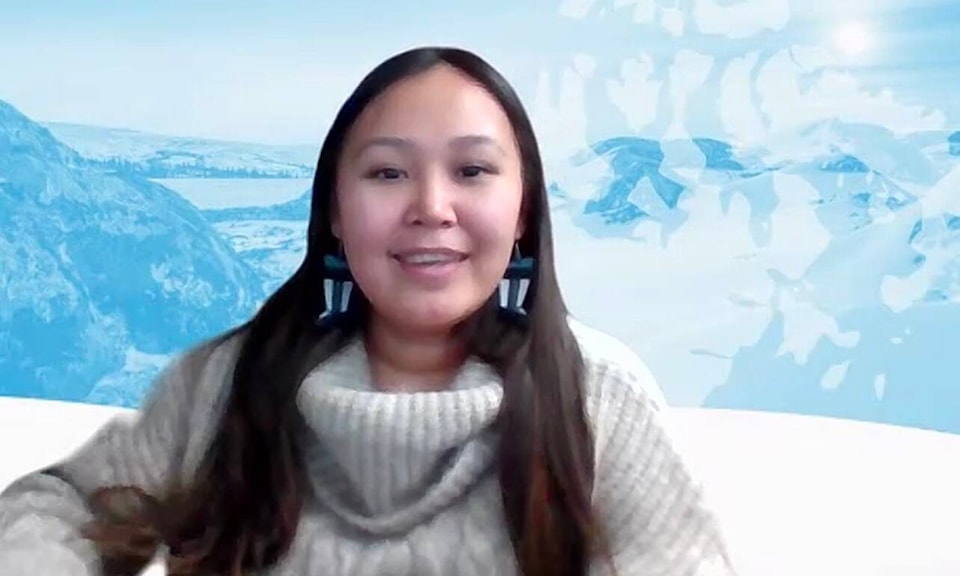There is an “increased demand” for healthcare professionals in Nunavut that’s going unmet, especially with “a continued lack of Inuit representation” in the field.
That’s according to Myca Nakashook, project officer for Nunavut Tunngavik Incorporated (NTI) and host of the joint Nunavut Arctic College (NAC) Nursing and University of Ottawa Medicine information session for prospective students on Jan. 31.
“For the last month, we’ve been focusing on nursing and medicine,” she said.
Speaking on the Makigiaqta Inuit Training Corporation’s new Healthcare Careers Capacity Development Initiative, Nakashook said NTI is continuing to work more closely with the Government of Nunavut, the Government of Canada, Inuit organizations, and Nunavut communities to offer “access to quality, culturally relevant education.”
Since these concerns fall directly under the mandate of Makigiaqta, which received an increase in funding through NTI recently, the organization has identified healthcare as a top priority for Nunavummiut pursuing advanced post-secondary training. This also comes with strengthened student funding support, enhanced wrap-around support, and a heightened outreach effort to engage with potential students. There will also be on-the-job and classroom-based programs with this new initiative “directly linked with employment and advancement… to address transitioning from education to work opportunities.”
Nunavut Arctic College nursing programs
The Nunavut Arctic College nursing program essentially provides three levels of education: a year-long pre-health sciences program; the four-year bachelor of science in Arctic nursing program, based in Iqaluit and run in partnership with Dalhousie University in Halifax; and more recently a two-year practical nursing program has been offered in Rankin Inlet.
“Presently there is no opportunity for a bridging program, but that may change in the future,” said Elissa Sakariassen, manager of nursing and health studies at NAC, in regards to the possibility of practical nursing program grads making the jump into the bachelor of science in Arctic nursing.
She also noted that there have been 77 graduates from the bachelor program to date, of whom 31 are Inuit. It is designed to reflect the diversity and culture of Nunavut, while reflecting the standards expected of nurses throughout Canada.
“Our class sizes tend to be small… for our nursing program here in Iqaluit, we’re looking at a cap of eight,” said Sakariassen. “It also has to do with our clinical partners and how many students they can truly accommodate for those clinical placements… [creating] great one-on-one support with instructors, so that tends to be nice for students. There’s generally a nice community feeling within the college.”
Indigenous Program in Ottawa
Luc Brisebois, the program coordinator for the Indigenous MD program at the University of Ottawa, which was established in 2005, said, “It works to create an inclusive and supportive environment for the success of Indigenous students. There’s a generous scholarship program, there’s a few special activities…I give support to all the medical Indigenous students.
“The partnership with the Government of Nunavut is fairly new — it’s two years old, and was created specifically to respond to the under-representation of Inuit in [medicine],” Brisebois added. “Once you are here, we provide support and mentorships for you. So we really just hope you’re going to join us shaping the future of Nunavut.”
“ᐊᖏᒡᓕᒋᐊᖅᑐᖅ ᐱᔭᐅᔪᒪᓂᖓ” ᐋᓐᓂᐊᓯᐅᖅᑏᑦ ᓄᓇᕗᒻᒥᑦ ᑎᑭᐅᑎᔭᐅᓯᒪᙱᖦᖢᓂ, ᐱᓗᐊᖅᑐᒥᑦ “ᐃᓄᒃᑕᖃᐅᖏᖃᑦᑕᕐᓂᖏᑦ” ᐱᓕᕆᐊᖑᔪᒥᑦ.
ᐅᖃᖅᑐᖅ ᒪᐃᑲ ᓇᑲᓱᒃ, ᐱᓕᕆᐊᕐᒧᑦ ᐱᓕᕆᔨᐅᔪᖅ ᓄᓇᕗᑦ ᑐᙵᕕᒃᑯᓐᓄᑦ ᐊᒻᒪᓗ ᑲᒪᔨᐅᓚᐅᖅᑐᖅ ᐊᑕᐅᑦᑎᒃᑯᑦ ᓄᓇᕗᒻᒥ ᓯᓚᑦᑐᖅᓴᕐᕕᒃ ᓇᔭᙳᐊᙳᕆᐅᖅᓴᓂᖅ ᐊᒻᒪᓗ ᐋᑐᕚᒥᑦ ᓯᓚᑦᑐᖅᓴᕐᕕᒡᔪᐊᕐᒥᑦ ᐃᖢᐊᖅᓴᐅᑎᓄᑦ ᑐᑭᓯᐅᒪᔾᔪᑏᑦ ᒥᒃᓵᓄᑦ ᑲᑎᒪᑎᑦᑎᓂᕐᒥᒃ ᐃᓕᓐᓂᐊᖅᑎᙳᕈᒪᔪᓄᑦ ᑕᖅᖀᓐᓇᕐᔪᐊᖅ 31-ᒥᑦ.
“ᑕᖅᕿᐅᓚᐅᖅᑐᒥᑦ, ᑕᐅᑐᒐᖃᖅᓯᒪᔪᒍᑦ ᓇᔭᙳᐊᓂᒃ ᐊᒻᒪᓗ ᐃᖢᐊᖅᓴᐃᓂᕐᒥᒃ,” ᐅᖃᖅᑐᖅ.
ᐅᖃᐅᓯᕆᔭᖓ ᒪᑭᒋᐊᖅᑕ ᐃᓄᖕᓂᒃ ᐊᔪᕈᖕᓃᖅᓴᐃᓂᕐᒧᑦ ᑯᐊᐳᕇᓴᒃᑯᑦ ᓄᑖᖅ ᐋᓐᓂᐊᓯᐅᖅᑎᙳᖅᓴᓂᕐᒧᑦ ᐱᕙᓪᓕᐊᓂᕐᒥᒃ ᐱᓕᕆᐊᒃᓴᖓᓄᑦ, ᓇᑲᓱᒃ ᐅᖃᖅᑐᖅ ᓄᓇᕗᑦ ᑐᙵᕕᒃᑯᑦ ᐱᓕᕆᖃᑎᖃᐃᓐᓇᖅᑐᑦ ᓄᓇᕗᒻᒥ ᒐᕙᒪᒃᑯᓐᓂᑦ, ᑲᓇᑕᒥᑦ ᒐᕙᒪᒃᑯᓐᓂᑦ, ᐃᓄᐃᑦ ᐊᐅᓚᑦᑎᔨᐅᔪᓂᒃ ᑲᑐᔾᔨᖃᑎᒌᓂᑦ, ᐊᒻᒪᓗ ᓄᓇᕗᒻᒥ ᓄᓇᓕᖕᓂᑦ ᑐᓂᓯᑉᓗᑎᒃ “ᐱᑦᑕᐅᔪᒥᒃ, ᐱᖅᖁᓯᕆᔭᐅᔪᒃᑯᑦ ᐃᓕᓐᓂᐊᕐᓂᕐᒥᒃ.”
ᐃᓱᒫᓘᑕᐅᔪᑦ ᐱᔭᒃᓴᐅᑎᒋᔭᖓᓃᒻᒪᑕ ᒪᑭᒋᐊᖅᑕ, ᑮᓇᐅᔭᖅᑖᖅᑎᑕᐅᒃᑲᓐᓂᓚᐅᖅᑐᖅ ᓄᓇᕗᑦ ᑐᙵᕕᒃᑯᑎᒍᑦ ᒫᓐᓇᓵᖑᓚᐅᖅᑐᒥᑦ, ᐊᐅᓚᑎᔨᐅᔪᖅ ᖃᐅᔨᓚᐅᖅᑐᖅ ᐋᓐᓂᐊᖃᖅᑕᐃᓕᒪᔪᓕᕆᓂᖅ ᖁᑦᑎᓛᒃᑯᑦ ᓯᕗᓪᓕᖅᐸᐅᑎᔭᐅᔪᒪᔪᖅ ᓄᓇᕗᒻᒥᐅᑦ ᖁᑦᑎᖕᓂᖅᓴᒥᒃ ᓯᓚᑦᑐᖅᓴᕐᕕᒃᑯᑦ ᐊᔪᕈᖕᓃᖅᓴᐃᓂᕐᒧᑦ. ᐃᓚᐅᔪᖅ ᓴᙱᒃᑎᒋᐊᖅᓯᒪᔪᖅ ᐃᓕᓐᓂᐊᖅᑎᒥᒃ ᑮᓇᐅᔭᓄᑦ ᐃᑲᔪᐃᓂᕐᒥᒃ, ᐱᐅᓯᒋᐊᖅᓯᒪᔪᒥᒃ ᐃᑲᔪᖃᑦᑕᕐᓂᐊᖅᑐᓂᒃ, ᐊᒻᒪᓗ ᖃᐅᔨᒋᐊᖃᑦᑕᕐᓂᖅᓴᐅᑉᓗᑎᒃ ᐃᓚᐅᖁᑉᓗᒋᑦ ᐃᓕᓐᓂᐊᖅᑎᐅᔪᒪᔪᓂᒃ. ᐱᓕᕆᓗᑎᒃ ᐃᓕᓐᓂᐊᕐᓗᑎᒡᓗ ᐱᑕᖃᕐᓂᐊᕐᒥᔪᖅ ᐊᒻᒪᓗ ᐃᓕᓐᓂᐊᕐᓗᑎᒃ ᑐᕌᖓᔪᓕᕆᓂᕐᓂᒃ ᓄᑖᖑᔪᖅ ᐱᓕᕆᐊᒃᓴᕆᔭᐅᔪᒥᑦ ᐱᔪᓂᒃ “ᐊᒃᑐᐊᔪᖅ ᐱᓕᕆᑎᑕᐅᓂᕐᒧᑦ ᐊᒻᒪᓗ ᓯᕗᒻᒧᖕᓂᐊᕐᓗᓂ… ᐱᓕᕆᐊᕆᓂᐊᕐᓗᒋᑦ ᐃᓕᓐᓂᐊᕌᓂᒃᐸᑕᒥᑦ ᐱᓕᕆᐊᖃᓕᕐᓂᕐᒧᑦ ᐱᕕᖃᖅᑎᑕᐅᓂᐊᕐᓗᑎᒃ.”
ᓄᓇᕗᑦ ᓯᓚᑦᑐᖅᓴᕐᕕᖕᒥᑦ ᓇᔭᙳᐅᙳᕆᐅᖅᓴᓂᕐᒧᑦ ᑐᕌᖓᔪᖅ ᐱᖓᓱᐃᖓᔪᒥᒃ ᐃᓕᓐᓂᐊᖅᑎᑕᐅᓂᐅᔪᖅ: ᐅᑭᐅᓗᒃᑖᕐᒥᒃ ᓯᕗᓂᐊᒍᑦ ᐋᓐᓂᐊᖃᖅᑕᐃᓕᒪᔪᓕᕆᓂᕐᒧᑦ ᖃᐅᔨᓇᓱᒃᑐᓕᕆᓂᕐᒥᒃ ᑐᕌᖓᔪᖅ; ᐃᒥᓱᓄᑦ ᐅᑭᐅᓂᒃ ᓯᓚᑦᑐᖅᓴᕐᕕᒡᔪᐊᕐᒥᑦ ᐃᓕᓐᓂᐊᕌᓂᒃᑐᖅ ᖃᐅᔨᓇᓱᒃᑐᓕᕆᓂᕐᒧᑦ ᐅᑭᐅᖅᑕᖅᑐᒥᑦ ᓇᔭᙳᐅᙳᕆᐅᖅᓴᑉᓗᓂ ᑐᕌᖓᔪᖅ, ᐃᖃᓗᖕᓂᑦ ᐊᒻᒪᓗ ᐊᐅᓛᕐᓗᓂ ᐱᓕᕆᖃᑎᒋᓗᒋᑦ ᑎᐅᓪᕼᐊᐅᓯ ᓯᓚᑦᑐᖅᓴᕐᕕᒡᔪᐊᖅ ᕼᐋᓕᕚᒃᔅᒥᑦ; ᐊᒻᒪᓗ ᒫᓐᓇᓵᖑᓕᖅᑐᒥᑦ ᒪᕐᕉᒃ ᐅᑭᐅᓄᑦ ᓇᔭᙳᐊᖑᓂᕐᒧᑦ ᑐᕌᖓᔪᖅ ᑐᓂᔭᐅᖃᑦᑕᓕᖅᑐᖅ ᑲᖏᖅᖠᓂᕐᒥᑦ.
“ᒫᓐᓇ ᐱᑕᖃᙱᑦᑐᖅ ᐱᖃᑖᓄᐊᕐᓂᐊᕐᓗᓂ ᐊᒃᑐᐊᔪᒥᒃ ᑐᕌᖓᔪᒥᑦ, ᑭᓯᐊᓂ ᑕᒪᓐᓇ ᐊᓯᐊᙳᑐᐃᓐᓇᕆᐊᖃᖅᑐᖅ ᓯᕗᓂᒃᓴᒥᑦ,” ᐅᖃᖅᑐᖅ ᐊᓕᓴ ᓴᑲᕆᐊᓯᓐ, ᐊᐅᓚᑦᑎᔨ ᓇᔭᙳᐊᓄᑦ ᐊᒻᒪᓗ ᐋᓐᓂᐊᖃᖅᑕᐃᓕᒪᓂᕐᒥᒃ ᖃᐅᔨᓴᐃᓂᕐᓄᑦ ᓄᓇᕗᒻᒥᑦ ᓯᓚᑦᑐᖅᓴᕐᕕᖕᒥᑦ, ᐅᖃᐅᓯᖃᖅᖢᓂ ᓇᔭᙳᐊᙳᕆᐅᖅᓴᓂᕐᒧᑦ ᑐᕌᖓᔪᒥᑦ ᐃᓕᓐᓂᐊᕌᓂᒃᑐᑦ ᐊᒥᓱᓄᑦ ᐅᑭᐅᓂᒃ ᓯᓚᑦᑐᖅᓴᕐᕕᒡᔪᐊᕐᒥᑦ ᖃᐅᔨᓇᓱᒃᑐᓕᕆᓂᕐᒧᐊᕐᓗᑎᒃ ᐅᑭᐅᖅᑕᖅᑐᒥᑦ ᓇᔭᙳᐊᖑᕆᐅᖅᓴᓂᕐᒧᑦ.
ᐅᖃᖅᖢᓂᓗ 77-ᖑᓚᐅᖅᑐᑦ ᐃᓕᓐᓂᐊᕌᓂᒃᑐᑦ ᐊᒥᓱᓄᑦ ᐅᑭᐅᓂᒃ ᓯᓚᑦᑐᖅᓴᕐᕕᒡᔪᐊᕐᒥᑦ ᐃᓕᓐᓂᐊᖅᑐᓂᑦ ᑐᕌᖓᔪᒥᑦ ᐅᑉᓗᒥᒧᑦ ᑎᑭᖦᖢᒍ, ᑖᑉᑯᓇᙵᑦ 31-ᖑᔪᑦ ᐃᓅᑉᓗᑎᒃ. ᐋᖅᕿᒃᑕᐅᓯᒪᔪᖅ ᑕᑯᒃᓴᐅᑎᓐᓂᐊᕐᓗᒋᑦ ᐊᔾᔨᒌᙱᑦᑑᑏᑦ ᐊᒻᒪᓗ ᐱᖅᖁᓯᕆᔭᖓ ᓄᓇᕗᑦ, ᐊᑕᐅᑦᑎᒃᑯᑦ ᑕᑯᒃᓴᐅᑎᓪᓗᒋᑦ ᐊᑐᖅᑕᐅᖃᑦᑕᖅᑐᑦ ᓂᕆᐅᒋᔭᐅᔪᑦ ᓇᔭᙳᐊᓂᑦ ᑲᓇᑕᒥᓗᒃᑖᖅ.
“ᐃᓕᓐᓂᐊᖅᑎᑉᑕ ᐊᖏᓂᖓ ᒥᑭᔫᔪᖅ… ᓇᔭᙳᐊᖑᖅᓴᓂᕐᒧᑦ ᑐᕌᖓᔪᖅ ᐃᖃᓗᖕᓂᑦ, ᐊᖏᓛᒃᑯᑦ 8-ᖑᔪᑦ,” ᐅᖃᖅᑐᖅ ᓴᑲᕆᐊᓯᓐ. “ᐱᑎᑦᑎᖕᒥᔪᑦ ᐃᖢᐊᖅᓴᐅᑎᓕᕆᓂᕐᒧᑦ ᐱᓕᕆᖃᑎᒋᔭᕗᑦ ᐊᒻᒪᓗ ᖃᑉᓯᐅᓂᖏᑦ ᐃᓕᓐᓂᐊᖅᑏᑦ ᐱᔪᖕᓇᖅᑕᖏᓐᓄᑦ ᐃᖢᐊᖅᓴᐅᑎᓕᕆᓂᕐᒧᐊᕐᓂᐊᖅᑐᓄᑦ…[ᓴᖅᕿᑦᑎᓂᖅ] ᐊᑕᐅᓯᐅᖃᑎᒋᓗᒋᑦ ᐃᑲᔪᖅᑕᐅᓗᑎᒃ ᐃᓕᓐᓂᐊᖅᑎᑦᑎᔨᓄᑦ, ᐱᐅᔫᖃᑦᑕᖅᑐᖅ ᐃᓕᓐᓂᐊᖅᑎᐅᔪᓄᑦ. ᐃᓚᒌᖕᓂᕐᒥᒃ ᐱᐅᔪᒥᒃ ᐃᒃᐱᖕᓇᖃᑦᑕᖅᑐᖅ ᓯᓚᑦᑐᖅᓴᕐᕕᖕᒥᑦ.”
ᓗᒃ ᐳᕇᔅᐳᐊ, ᑐᕌᖓᔪᒧᑦ ᑐᑭᒧᐊᒃᑎᑦᑎᔨ ᓄᓇᖃᖅᖄᖅᑐᑦ MD ᑐᕌᖓᔪᒧᑦ ᓯᓚᑦᑐᖅᓴᕐᕕᒡᔪᐊᖅ ᐋᑐᕚᒥᑦ, ᓴᖅᕿᑕᐅᓚᐅᖅᑐᖅ 2005-ᒥᑦ, ᐅᖃᑐᖅᑐᖅ, “ᐊᔪᙱᑦᑐᖅ ᓴᖅᕿᑦᑎᓂᐊᕐᓗᓂ ᐃᓚᐅᑎᑦᑎᔪᒥᒃ ᐊᒻᒪᓗ ᐃᑲᔪᖃᑦᑕᕐᓗᑎᒃ ᐱᐊᓂᑦᑎᐊᖅᓯᒪᓂᐊᕐᓗᑎᒃ ᓄᓇᖃᖅᖄᖅᑐᑦ ᐃᓕᓐᓂᐊᖅᑎᓂᑦ. ᐱᐅᔪᒥᒃ ᐃᓕᓐᓂᐊᖅᑎᓄᑦ ᐃᑲᔫᐃᓂᕐᒧᑦ ᑐᕌᖓᔪᖅᑕᖃᖅᑐᖅ, ᖃᑉᓯᐊᕐᔫᔪᑦ ᐊᔾᔨᐅᖏᑦᑐᑦ ᖃᓄᐃᓕᐅᕈᑏᑦ… ᐃᑲᔪᖅᑕᒃᑲᑦ ᑕᒪᕐᒥᓗᒃᑖᖅ ᐃᖢᐊᖅᓴᐃᓂᕐᒧᑦ ᓄᓇᖃᖅᖄᖅᑐᑦ ᐃᓕᓐᓂᐊᖅᑏᑦ.
“ᐱᓕᕆᖃᑎᒋᔭᐅᓂᖏᑦ ᓄᓇᕗᒻᒥ ᒐᕙᒪᒃᑯᑦ ᓄᑖᖑᔪᖅ - ᒪᕐᕉᖕᓂᒃ ᐅᑭᐅᓅᓕᖅᑐᖅ, ᐊᒻᒪᓗ ᓴᖅᕿᑕᐅᓚᐅᖅᑐᖅ ᐅᐸᓗᐊᓗᐊᕐᓂᐊᕐᓗᓂ ᑭᒡᒐᖅᑐᖅᑕᐅᓂᖃᓗᐊᖏᑦᑐᓂᑦ ᐃᓄᖕᓂᑦ [ᐃᖢᐊᖅᓴᐅᑎᓄᑦ],” ᐳᕇᔅᐳᐊ ᐃᓚᓯᔪᖅ. “ᑕᒡᕙᓃᓕᕈᕕᑦ, ᐃᑲᔪᕐᓂᐊᖅᑐᑦ ᐊᒻᒪᓗ ᐅᖃᓪᓚᐅᔾᔨᖃᑦᑕᕐᓗᑎᒃ ᐱᔾᔪᑎᓗᑎᑦ. ᑕᐃᒪᑐᖅ ᐅᕙᑉᑎᖕᓂᑦ ᐃᓚᐅᓂᐊᖅᐳᑎᑦ ᐋᖅᕿᒃᓯᓂᕐᒧᑦ ᓯᕗᓂᒃᓴᖓᓂᑦ ᓄᓇᕗᑦ.”
